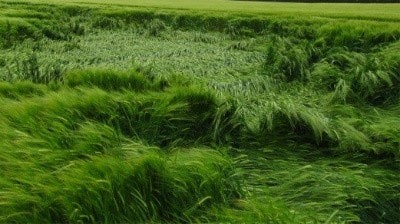Lignify it, and it won’t fall
When the gravity pulling your crop down to the ground is stronger than the counter forces keeping it standing, lodging will occur. Crop lodging causes serious losses of yield and quality in many crops grown in Western Canada, especially cereals. Assessing the root cause of lodging and taking measures to help prevent it are key for guaranteeing crop standability and preserving yield and quality.
Crop lodging
Crop lodging can often be attributed to either root or stem failure. Soil composition, along with commonly used farm practices, especially the excessive use of nitrogen, can predispose crops to lodge. Root lodging often occurs early in the season when root development is poor, often due to manganese deficiency and/or disease (i.e., take-all).
Oppositely, stem failure occurs later in the season when the weight of the heads causes the stem to collapse. This collapse occurs at the weakest point in the stem and is most likely to be seen when there is heavy rain, or strong winds. That is often a sign of a poor lignin buildup due to either the content or quality of lignin.

What causes lodging?
Many factors can contribute to crop lodging. These include:
- Nitrogen: Excessive application of nitrogen, often combined with a heavy seeding rate or the use of tall varieties is the predominant cause of lodging in cereals. Heavy application of nitrogen prior to seeding or before the start of stem elongation often produces weaker stems with longer internodes
- Insufficient Root Development: When the growing conditions don’t allow for sufficient development of crown roots, crop anchorage remains shallow, exposing the crop to lodging, especially under heavy rains or strong winds
- Heavy Rain or Irrigation: Heavy rain or irrigation can damage the top 2” of soil and increase the risk of root lodging. In addition, irrigated crops stay in the ground for longer, increasing the possibility of wind damage prior to harvest
- Take-all: Take-all disease can spread rapidly in the field when crop rotation is tight, weakening the plants and making them vulnerable to lodging
- Heavy manure: Heavily-manured land with poor potassium and/or manganese levels can also cause lodging.
By understanding these contributing factors, you can choose the right crop variety for your local conditions. For instance, taller varieties should not be sown early, as earlier seeding makes the crop grow taller and produce more tillers with longer, thinner and weaker stems. Likewise, a poor rooting variety cannot be chosen for late seeding and cannot be seeded at a heavy rate, especially when the field is lacking manganese or potassium.
How OMEX Can Help?
Options to prevent or reduce crop lodging focus on improving root growth and development in the early stages of crop growth, encouraging lateral growth and/or the reduction of crop height and increasing lignin content to strengthen the stem.
To help develop a strong root system that is able to absorb water and nutrients while firmly anchoring the crop into the soil, I recommend starting the season with an OMEX Primer, especially Primer Mn. Primer Mn allows the seedlings to early access phosphorus, potassium, zinc and manganese for healthy roots and promotion of lateral growth prior to the 3-5 leaf stage.
The use of Plant Growth Regulators (PGRs) to control the height of the crop will minimize the chances of falling over, and the addition of key micronutrients at critical stages – flag leaf and prior to stem elongation – will trigger lignin synthesis and accumulation in the stems. This will allow the plant stems to remain sturdy and able to withstand heavy rain and/or strong winds.
Talk to your OMEX Representative or ag retailer today about strategies to help keep your plants up! Your rep can provide information about the OMEX products that can prevent lodging in your crop, along with great crop nutrition advice.
